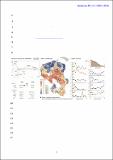Por favor, use este identificador para citar o enlazar a este item:
http://hdl.handle.net/10261/235033COMPARTIR / EXPORTAR:
 SHARE SHARE
 CORE
BASE CORE
BASE
|
|
| Visualizar otros formatos: MARC | Dublin Core | RDF | ORE | MODS | METS | DIDL | DATACITE | |

| Título: | Spatial distribution of fallout and lithogenic radionuclides controlled by soil carbon and water erosion in an agroforestry South-Pyrenean catchment |
Autor: | Gaspar Ferrer, Leticia CSIC ORCID ; Lizaga Villuendas, Iván CSIC ORCID ; Navas Izquierdo, Ana CSIC ORCID | Palabras clave: | 137Cs, 210Pbex, 238U, 226Ra, 232Th, 40K Gamma spectrometry SOC SIC Parent material Soil redistribution |
Fecha de publicación: | jun-2021 | Editor: | Elsevier | Citación: | Gaspar L, Lizaga I, Navas A. Spatial distribution of fallout and lithogenic radionuclides controlled by soil carbon and water erosion in an agroforestry South-Pyrenean catchment. Geoderma 391 (1): 114941 (2021) | Resumen: | The mineral composition of soils and weathering processes are known to control the natural radioactivity of soils but research on the influence of water erosion and of main soil properties in the spatial variability of lithogenic and fallout radionuclides remains little investigated in heterogeneous agroecosystems with complex landscape. An extensive study was conducted to determine the mass activities of fallout (137Cs, 210Pbex) and lithogenic radionuclides (238U, 226Ra, 232Th, 40K) an assess the main controls affecting their spatial variations in a representative 2.5 km2 Pre-Pyrenean catchment of north-eastern Spain. The complex agroforestry catchment holds two distinctive parent materials, Muschelkalk limestones and Keuper argillaceous marls, in which the variability of the main soil properties and soil erosion patterns are well characterised. A total of 228 soil samples have been measured by using a high-purity germanium detector. Lithological influence on the variability of radionuclides was investigated and our results indicate that there are strong significant differences between the mass activities of 137Cs, 210Pbex, 226Ra and 40K based on the two different parent materials. Positive correlations were found among the radioactivity contents of 232Th and 40K and the clay content. Total organic carbon (SOC) was also positively correlated with 137Cs, 210Pbex and 226Ra activities, whereas carbonate content and SIC were negatively correlated with the radionuclides with higher significance in soils on limestones. To gain knowledge on the spatial variability of the radionuclides within the landscape, maps of the distribution of radionuclides were generated by GIS interpolation tools of the entire set of measured activities and soil properties within a 100 × 100 m grid. The spatial patterns obtained, besides the variations of radionuclides along four selected transects, confirm the key role of water erosion in the mobilisation of fallout radionuclides, especially 137Cs, while lithogenic radionuclides were sensitive to physical processes in areas where soil loss was intense. This study not only filled the gap of radioactivity data in agroforestry systems with contrasting parent materials, but also shed light on the potential of radionuclides for tracking soil redistribution processes in fingerprints studies. | Descripción: | 39 Pags.- 6 Figs.- 4 Tabls. | Versión del editor: | https://doi.org/10.1016/j.geoderma.2021.114941 | URI: | http://hdl.handle.net/10261/235033 | DOI: | 10.1016/j.geoderma.2021.114941 | ISSN: | 0016-7061 |
| Aparece en las colecciones: | (EEAD) Artículos |
Ficheros en este ítem:
| Fichero | Descripción | Tamaño | Formato | |
|---|---|---|---|---|
| GasparL_Geoderma_2021.pdf | 1,84 MB | Adobe PDF |  Visualizar/Abrir |
CORE Recommender
SCOPUSTM
Citations
12
checked on 21-abr-2024
WEB OF SCIENCETM
Citations
11
checked on 29-feb-2024
Page view(s)
80
checked on 23-abr-2024
Download(s)
19
checked on 23-abr-2024
Google ScholarTM
Check
Altmetric
Altmetric
NOTA: Los ítems de Digital.CSIC están protegidos por copyright, con todos los derechos reservados, a menos que se indique lo contrario.
